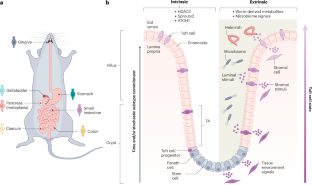Tuft cells in the intestine, immunity and beyond
IF 45.9
1区 医学
Q1 GASTROENTEROLOGY & HEPATOLOGY
引用次数: 0
Abstract
Tuft cells have gained substantial attention over the past 10 years due to numerous reports linking them with type 2 immunity and microorganism-sensing capacity in many mucosal tissues. This heightened interest is fuelled by their unique ability to produce an array of biological effector molecules, including IL-25, allergy-related eicosanoids, and the neurotransmitter acetylcholine, enabling downstream responses in diverse cell types. Operating through G protein-coupled receptor-mediated signalling pathways reminiscent of type II taste cells in oral taste buds, tuft cells emerge as chemosensory sentinels that integrate luminal conditions, eliciting appropriate responses in immune, epithelial and neuronal populations. How tuft cells promote tissue alterations and adaptation to the variety of stimuli at mucosal surfaces has been explored in multiple studies in the past few years. Since the initial recognition of the role of tuft cells, the discovery of diverse tuft cell effector functions and associated feedback loops have also revealed the complexity of tuft cell biology. Although earlier work largely focused on extraintestinal tissues, novel genetic tools and recent mechanistic studies on intestinal tuft cells established fundamental concepts of tuft cell activation and functions. This Review is an overview of intestinal tuft cells, providing insights into their development, signalling and interaction modules in immunity and other states. Tuft cells have important roles in type 2 immunity and antimicrobial responses in mucosal tissues. This Review provides an overview of intestinal tuft cells, providing insights into their phenotype, function and role in the intestine in immunity and other states.


肠道中的簇细胞、免疫力及其他
在过去的 10 年中,簇状细胞受到了广泛关注,因为有大量报道称簇状细胞与许多粘膜组织的 2 型免疫和微生物感应能力有关。它们能产生一系列生物效应分子,包括 IL-25、与过敏相关的类二十烷酸和神经递质乙酰胆碱,从而在不同类型的细胞中产生下游反应。簇细胞通过 G 蛋白偶联受体介导的信号通路运作,让人联想到口腔味蕾中的 II 型味觉细胞,簇细胞作为化学感觉哨兵整合腔内条件,引起免疫、上皮和神经元群体的适当反应。在过去几年中,多项研究探讨了簇细胞如何促进组织改变和适应粘膜表面的各种刺激。自最初认识到丛细胞的作用以来,对丛细胞多种效应器功能和相关反馈回路的发现也揭示了丛细胞生物学的复杂性。虽然早期的工作主要集中在肠外组织,但新型遗传工具和最近对肠道簇细胞的机理研究确立了簇细胞活化和功能的基本概念。本综述概述了肠簇细胞,深入探讨了它们在免疫和其他状态下的发育、信号传递和相互作用模块。
本文章由计算机程序翻译,如有差异,请以英文原文为准。
求助全文
约1分钟内获得全文
求助全文
来源期刊
CiteScore
52.30
自引率
0.60%
发文量
147
审稿时长
6-12 weeks
期刊介绍:
Nature Reviews Gastroenterology & Hepatology aims to serve as the leading resource for Reviews and commentaries within the scientific and medical communities it caters to. The journal strives to maintain authority, accessibility, and clarity in its published articles, which are complemented by easily understandable figures, tables, and other display items. Dedicated to providing exceptional service to authors, referees, and readers, the editorial team works diligently to maximize the usefulness and impact of each publication.
The journal encompasses a wide range of content types, including Research Highlights, News & Views, Comments, Reviews, Perspectives, and Consensus Statements, all pertinent to gastroenterologists and hepatologists. With its broad scope, Nature Reviews Gastroenterology & Hepatology ensures that its articles reach a diverse audience, aiming for the widest possible dissemination of valuable information.
Nature Reviews Gastroenterology & Hepatology is part of the Nature Reviews portfolio of journals.

 求助内容:
求助内容: 应助结果提醒方式:
应助结果提醒方式:


